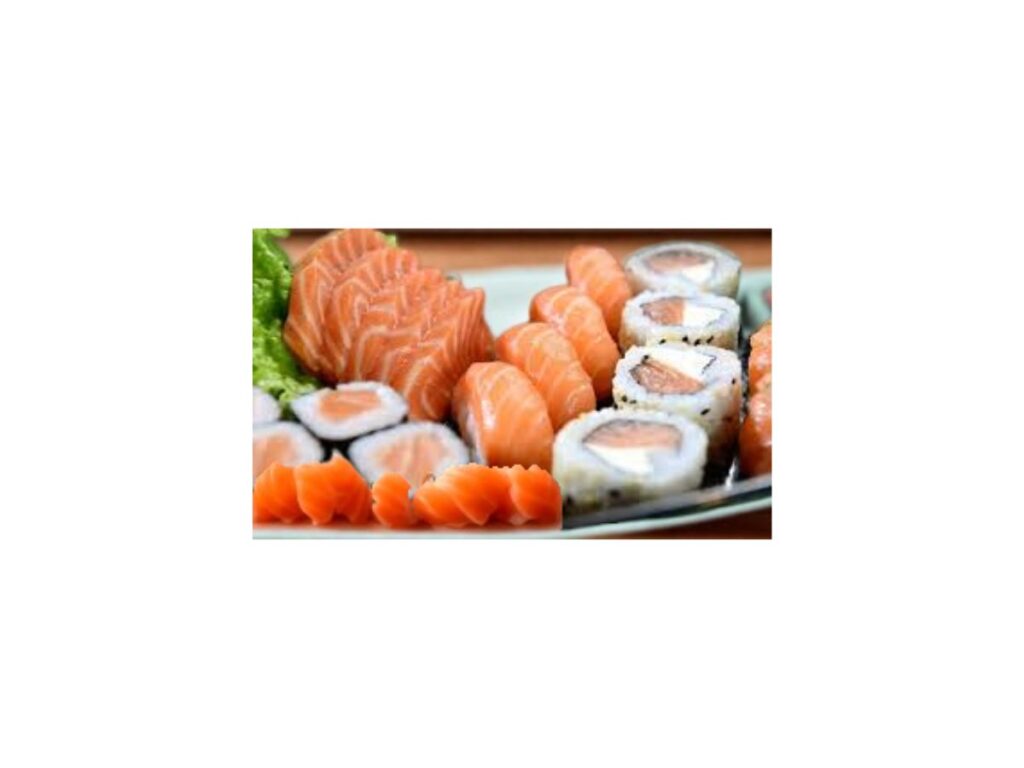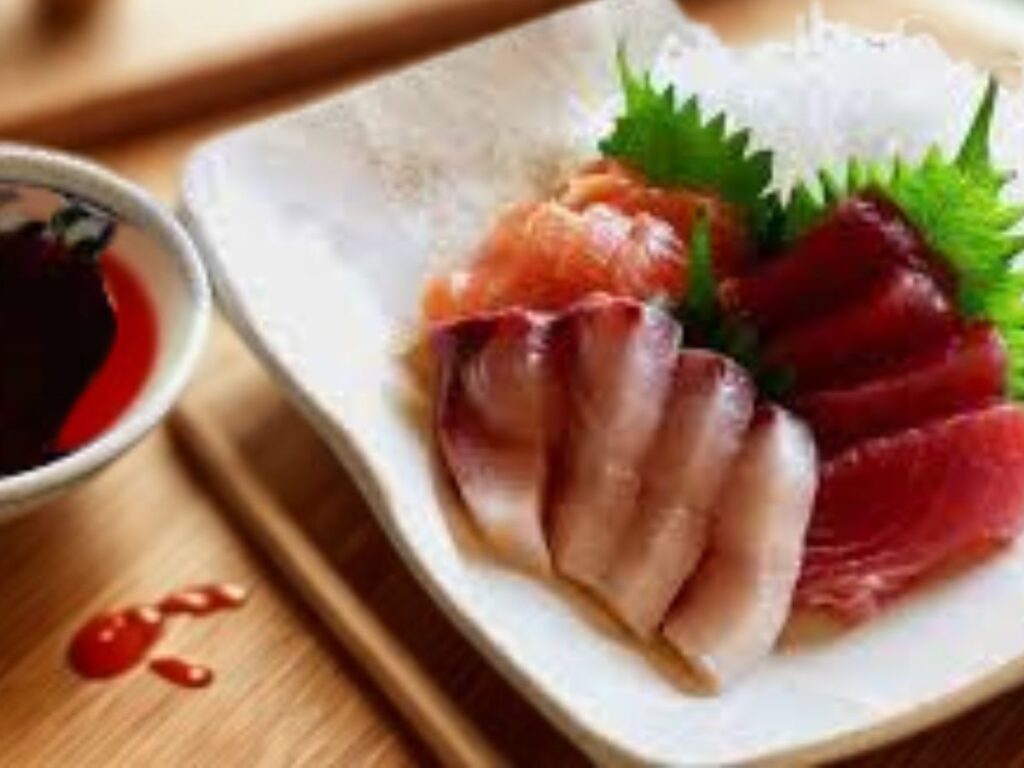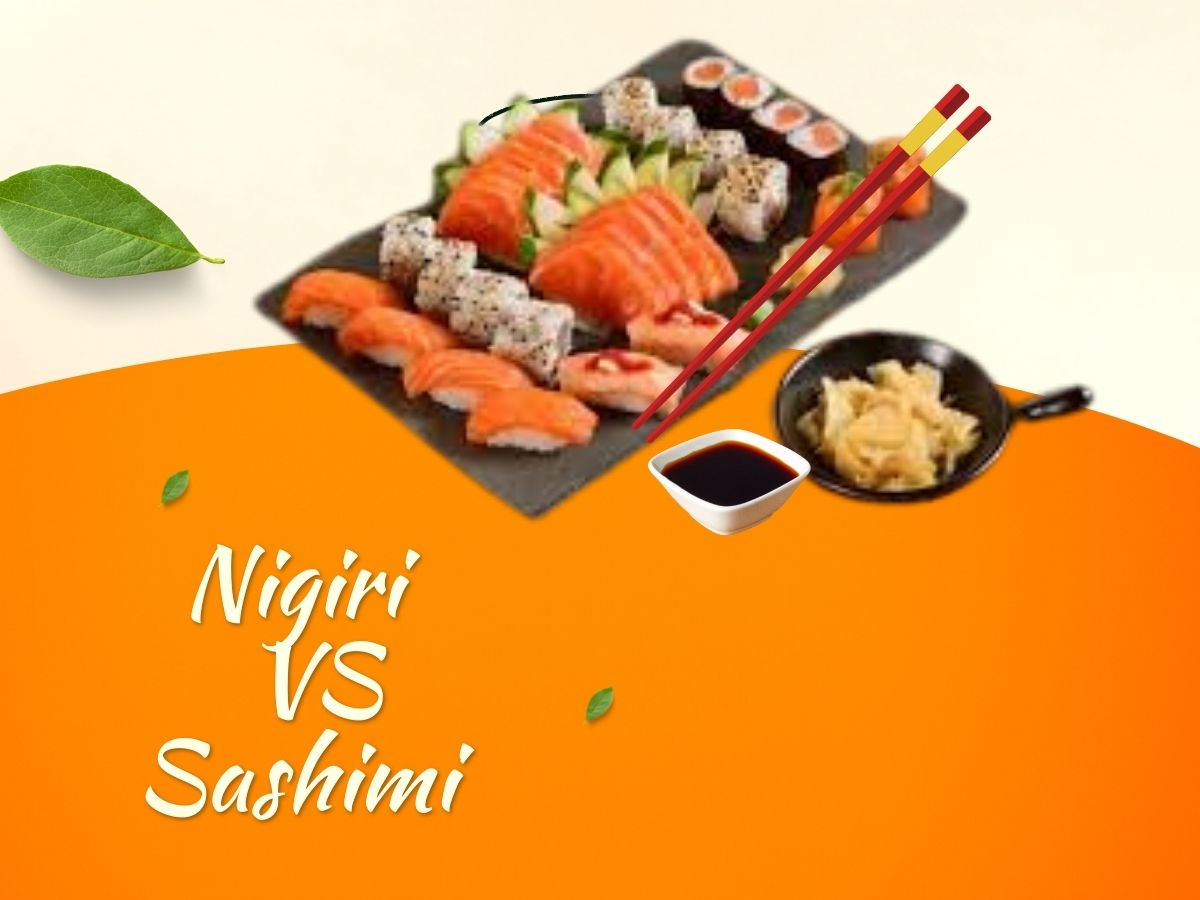There are so many sushi choices at a Japanese restaurant that it can be hard to know what to order. People often get confused about Nigiri vs Sashimi. Both dishes use fresh fish, but they are cooked and served in different ways. This guide will help you understand the differences between nigiri and sashimi so you can make an informed choice the next time you go.
What is Nigiri?
Nigiri is a kind of sushi that is made with just two simple things: fresh fish and seasoned rice. In Japanese, the word “nigiri” means “hand-pressed.” A skilled chef takes a small amount of sushi rice, shapes it by hand, and then puts a piece of fresh fish on top. Nori, a thin strip of seaweed, is sometimes used to hold everything together.
What is sashimi?
Sashimi is a dish that shows off how good the fish is. It’s just fresh, raw fish cut into thin slices. There are no rice, seaweed, or other ingredients. “Sashimi” means “pierced body” in Japanese, which refers to how the fish is cut.
Nigiri vs Sashimi: Key Differences
| Nigiri | Sashimi | |
| Ingredients | fresh fish on seasoned sushi rice | Just fish, no rice |
| Preparation | Fish is placed on top of hand-pressed rice | Fish is cut into pieces and served on its own. |
| serving | two pieces per serving | 3 to 5 pieces per serving |
| Eating Method | You can eat nigiri with your hands or chopsticks. | Always eaten with chopsticks |
What is the difference between nigiri, sashimi, and sushi?
A lot of people don’t know the difference between sushi, nigiri, and sashimi. Here’s a simple explanation:
| Sushi | Nigiri | Sashimi |
| Sushi is any dish that has seasoned rice in it, like nigiri, maki rolls, and more. | Nigiri is a sushi that has fish on rice. | Sashimi is not sushi at all; it’s just raw fish cut into pieces. |
Nigiri vs Sashimi vs Maki: Three Popular Options
| Maki | Nigiri | Sashimi |
| Maki is a different kind of sushi that has rice and fillings inside and is rolled up in seaweed. | Nigiri: Rice with fish on top, eaten in one or two bites | Sashimi is just fish, no rice, and you eat it with chopsticks |

Classic Nigiri Recipe (Traditional Japanese Method)
Recipe Overview
| Prep Time | 45 min |
| Cook Time | 20 min |
| Total Time | 1 hour 5 minutes |
| Serving Size | 2-3 people |
| Difficulty Level | Intermediate |
| Cuisine | Traditional Japanese |
| Special Equipment | Sharp knife, wooden rice paddle, wooden bowl (preferred) |
Ingredients For Sushi Rice:
- 1½ cups Japanese short-grain rice (like Koshihikari)
- 1¾ cups filtered water
- 3 tablespoons rice vinegar
- 2 tablespoons sugar
- 1½ teaspoons sea salt
For Nigiri:
- 10 slices sashimi-grade fish (2-3 oz each)
- Tuna (maguro)
- Salmon (sake)
- Yellowtail (hamachi)Fresh wasabi (not powder)
- Small bowl of water with rice vinegar (for wet hands)
Traditional Procedure
Step 1: Perfect Sushi Rice (Shari)
- Rinsing: Wash rice in cold water 4-5 times until water runs almost clear
- Soaking: Let rice sit in water for 30 minutes before cooking
- Cooking: Use rice cooker or pot with tight lid. Bring to boil, then simmer 18 minutes
- Make sushi vinegar: Heat vinegar, sugar, and salt until dissolved. Let cool
- Seasoning: Transfer hot rice to wooden bowl. Add vinegar mixture while fanning rice
- Cooling: Mix gently with wooden paddle until rice reaches body temperature
Step 2: Prepare Fish
- Check quality: Fish should smell like ocean, not fishy
- Sharp knife: Use very sharp knife for clean cuts
- Cut fish: Slice against grain, ¼ inch thick, 2-3 inches long
- Keep cold: Place fish on ice until ready to use
Step 3: Form Nigiri (Traditional Hand Method)
- Wet hands: Dip hands in vinegar water to prevent sticking
- Take rice: Use about 1 tablespoon of rice (20-25 grams)
- Shape rice: Form oval shape using light pressure – rice should hold together but not be packed tight
- Add wasabi: Put tiny amount (size of rice grain) on rice
- Place fish: Lay fish slice over rice, gently curving to match rice shape
- Final press: Lightly press fish to rice using thumb and fingers
- Perfect shape: Nigiri should be about 2 inches long, neat and uniform
Step 4: Professional Finishing Touches
- Check temperature: Rice should be body temperature, fish cold
- Inspect shape: Each piece should look identical
- Immediate serving: Serve within 10 minutes of making
Traditional Temperature Guide
- Sushi rice: 98°F (body temperature)
- Fish: 35-40°F (refrigerator cold)
- Room: 65-70°F for comfortable eating
- Serving plate: Slightly chilled
Classic Nigiri Variations
| Maguro Nigiri (Tuna | Sake Nigiri (Salmon) | Hamachi Nigiri (Yellowtail) | Ebi Nigiri (Shrimp) | Tamago Nigiri (Egg) |
| Most traditional, rich flavor | Popular modern choice, buttery texture | Delicate, slightly fatty | Cooked shrimp, sweet and firm | Sweet egg omelet, often served last |
Professional Tips from Sushi Masters
- Rice grains should be visible, not mushy
- Never squeeze rice too tight – it should be “like holding a small bird”
- Fish should drape naturally over rice
- Each piece should be eaten in one bite
- Always use sashimi-grade fish from trusted suppliers

Classic Sashimi Recipe (The Method of Japan)
Recipe Overview
| Prep Time | 45 min |
| Cook Time | 0 min |
| Total Time | 45 minutes |
| Serving Size | 2-3 people |
| Difficulty Level | Intermediate |
| Cuisine | Traditional Japanese |
| Special Equipment | Sharp sashimi (yanagiba) knife, ice, sashimi plates |
Ingredients
- 8 oz sashimi-grade fish (choose 2-3 varieties):
- 3 oz Tuna (maguro)
- 3 oz Salmon (sake)
- 2 oz Yellowtail (hamachi)
- Ice Cubes (to cool the fish)
- Traditional Garnish:
- 1 daikon radish ( julienne cut)
- 1 cucumber ( sliced)
- Shiso (Japanese mint)
- gari (pickled ginger)
- Fresh wasabi root (not powder)
- For Serving:
- High quality shoyu (soy sauce)
- Wasabi paste
- Small ceramic dipping dishes
Traditional Procedure
- Step 1: Fish Selection and Preparation
- Buy from trusted source: Only purchase from reputable fishmonger with sashimi-grade certification
- Upon checking the freshness: Fish should have a brilliant color, a firm texture, and an ocean (not fishy) scent.
- Chilling the fish: Store fish on ice until you’re ready to cut (32-35 degrees).
- Refrigerator: Only remove fish when you’re about to slice.
- Step 2: Prepare Garnishes (Traditional Style)
- Daikon: Peel the skin, and slice it into julienne strips (noodles).
- Cucumber: Slice ultra thin with a knife or mandoline.
- Shiso leaves: Wash then pat dry
- Ice water: Soak daikon in water with ice for 10 minutes, for it to be crispy.
- Step 3: Slicing Sashimi (Hiki-zukuri)
- Sharp knife essential: Yanagiba, or the sashimi knife, or the very sharpest knife you have.
- Proper Angle: You must set the fish horizontally, while the knife has to be at a 45-degree angle to the fish.
- Single Stroke: You have to cut the fish at one single stroke without sawing back and forth the fish.
- Slice Thickness: The cut should be between one quarter and three eighths thick.
- Cut Against The Grain: You must always slice perpendicular to the muscle or muscle fibers.
- Clean Knife: You have to wipe the cut and clean the blade.
- Step 4: Traditional Techniques By Type Of Bone
- Cutting Tuna (Maguro):
- Remove any visible dark red muscle (chiai). Cut into rectangular pieces no longer than 2 and a half inches. All pieces must be the same thickness.
- Cutting Salmon (Sake):
- first Remove the skin and the brown mea than Cut at a very slight angle to increase surface area. They should be a tad thicker than the pieces of tuna.
- Cutting Yellowtail (Hamachi):
- Keep a bit of the fatty belly part. Slice into beautiful rectangular pieces and make sure to take out the bones carefully.
- Step 5: Professional Presentation (Mori-tsuke)
- Take plates that have been stored in the refrigerator and have a nice chill to the fish. Place the lightest fish at the start and the darkest at the end. Now Overlap the pieces a bit and arrange then in beautiful fanning. Place a few pieces of daikon, cucumber and shiso for garnish in a nice arrangement. Add a small mountain of fresh wasabi and serve with great speed. The sashimi should never be out of the refrigerator and the temperature should always be 65-68 degrees.
- Eating temperature: When sashimi is served it is expected to be cold
Classic Sashimi-varieties and their attributes
| Maguro sashimi | Sake Sashimi | Hamachi Sashimi | Hirame Sashimi | |
| Taste | Sweet mellow meaty | Mild buttery overly soft | Tender clean sweet | Clean ocean taste |
| Texture | Gentle yet firm | Orange-pink with white fat | Well fatty and soft | Chewy and firm |
| Appearance | Dark red to deep red | Orange-pink with white fat | White and pale pink | White and translucent |
Professional Tips from Sashimi Masters
- Keep blades sharp as possible, a dull knife will shred fish fibers.
- Fish must not warm up during the cutting process.
- Clean the area as soon as the fish is cut as knives can get about the fish and be contaminated.
- Serve and cut within a 5 minute interval for the fish to be the best quality possible.
- Serve the best pieces opposed to mass pieces that are mid quality to be served.
- Use as much of the fish as possible and throw away as little as possible.
- With sashimi, it is advised to only use chopsticks, and not to touch the Sashimi with the hands.
Serving Guide
How to Eat Nigiri
- Pick up with fingers or chopsticks
- Dip fish side (not rice) lightly in soy sauce
- Eat in one or two bites
- Fish side should touch your tongue first
How to Eat Sashimi
- Cleanse palate with pickled ginger between different fish types
- Always use chopsticks
- Dip in soy sauce mixed with wasabi
- Eat in one bite if possible
Health Benefits
| Nigiri Benefits | Sashimi Benefits |
| High-quality protein from fish | Pure protein |
| Carbohydrates from rice | No carbohydrates |
| Omega-3 fatty acids Good for heart health | Contains a high amount of vitamins and minerals |
| Each piece has about 70 to 80 calories. | Low in calories,each piece has about 25 to 40 calories. |
Common types of Nigiri vs Sashimi
| Nigiri Varieties | Sashimi Varieties |
| Salmon nigiri: has a mild taste and butter-like flavour | Salmon sashimi: Popular starter choice |
| Tuna nigiri: it has a more meaty and rich taste | Tuna sashimi: Classic option with rich taste |
| Yellowtail nigiri: contains more fats, which makes it very smooth | Yellowtail sashimi: Delicate and fatty |
| Shrimp nigiri: It is sweet and firmer | Sea bass sashimi: Light and clean flavor |
Nigiri vs Sashimi: Taste Comparison
Nigiri taste: The combination of fish and seasoned rice creates a balanced flavor. The rice adds a slightly sweet and tangy taste that complements the fish.
Sashimi taste: You get the pure, clean taste of the fish without any other flavors. This lets you really appreciate the quality and freshness of the seafood.
The next time someone asks about nigiri vs sashimi, you’ll be able to explain that one has rice (nigiri) and one doesn’t (sashimi). You’ll also know that both require high-quality, fresh fish and skilled preparation to taste their best. Try both choices to see which one you like better. Depending on their mood, appetite, and what they’re craving, a lot of sushi lovers like both. The most important thing is to buy from trusted sources and enjoy these beautiful examples of Japanese food.
Why is Sashimi More Expensive Than Nigiri?
Sashimi costs more because:
- Only the best fish works because there is no rice to hide the flavors.
- With sashimi, you get more real fish.
- Proper cutting takes more training
- It must be very fresh, which costs more
FAQS
Do you eat nigiri in one bite?
Nigiri can be eaten in one or two bites, depending on the size. It is polite to take one bite if you can, but two bites are fine too.
What is the difference between sashimi and nigiri, and uramaki?
Sashimi: No rice, just sliced fish
Nigiri: Fish on rice
Uramaki: Inside-out roll with rice on the outside and nori on the inside
Can I make these at home?
Yes, but you need to get sashimi-grade fish from a trusted source. Never use regular fish from the grocery store for raw preparations.
How long do they stay?
You should eat both right after you make them. You should never keep leftover nigiri or sashimi.
What kind of fish is best for beginners?
Salmon is usually the best choice for people new to raw fish because of its mild flavor and smooth texture.
Do I need any special tools?
For nigiri, you need good sushi rice and fresh fish. For sashimi, a very sharp knife is essential for clean cuts.
conclusion
Understanding the difference between nigiri vs sashimi helps you make better choices when dining at Japanese restaurants. Nigiri is a more filling and balanced choice because it combines the flavors of fresh fish and seasoned rice. Sashimi offers the pure taste of high-quality fish without any additions.
Both choices are very healthy and are based on centuries of Japanese cooking. Both nigiri and sashimi are great ways to enjoy fresh seafood, whether you like the full experience of nigiri or the simple taste of sashimi. The next time someone asks about nigiri vs sashimi, you’ll be able to explain that one has rice (nigiri) and one doesn’t (sashimi). You’ll also know that both require high-quality, fresh fish and skilled preparation to taste their best.
Try both choices to see which one you like better. Depending on their mood, appetite, and what they’re craving, a lot of sushi lovers like both. The most important thing is to buy from trusted sources and enjoy these beautiful examples of Japanese food.









